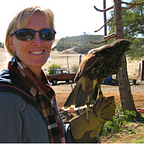The Driving Reign
From noble wines to regal raptors on the “Castle Road” of France.
Story & photos by Erin Deinzer
Like many an obsessive “Game of Thrones” fan, I’m entranced by the idea of life in medieval Europe—including fairy tale images of castles, and the raptors that carried messages back-and-forth between them. To satisfy my desire to see some of those elaborate edifices in person, my husband agreed to a 3-day sojourn to the Alsace-Lorraine region of France.
Leaving Paris on a brilliant sunny day, we boarded the high-speed train for Strasbourg, where we promptly hired a rental car. We’d been told by French friends that the best way to explore the famous Wine Route would be on our own terms—both for scheduling purposes, as well as for accommodating unexpected moments of serendipity.
The Alsace region is a narrow, 130-mile long strip of land lying between the Vosges Mountains and the Rhine River. Here, the influence of nearby Germany is obvious: from the hearty fare served in local restaurants to the storybook architecture of its buildings. And the names of some of the villages along the route—Molsheim, Rosenwiller, Reichsfeld—underscore that Germanic influence.
The wines produced in the area are sweeter varieties: in particular, Gewurtztraminer and Riesling—two of my personal favorites. Stepping into a local winstub (or wine bar), we were able to locate a fabulous organic Riesling, which we savored along with some locally made cheese and freshly baked bread at a patio table overlooking the main square of the flower-bedecked town of Eguisheim.
Noted as a “cradle of Alsace viticulture at the foot of three castles,” the medieval city was also the birthplace of Pope S. Leo IX in 1002. And if that’s not enough history for you, it also lays claim to a Romanesque church with a 13th-century belfry and the remains of an octagonal Roman castle from 780 AD.
We left the charming enclave of Eguisheim and headed for one of the most prominent castles in the region: Chateau du Haut-Koenigsbourg. Located at the top of a mountain, the castle overlooks numerous villages and offers a spectacular panoramic view of the verdant countryside. A brochure from the castle’s admission desk states that “from the Grand Bastion, you can see the Alsace plain, the Vosges, the Black Forest, and on a clear day, the Alps…”
It was a pretty clear day, but we weren’t equipped with high-power binoculars so we settled for the view visible with the naked eye. At the base of the mountain we spied villages with neat rows of grapevines, tidy homes with red-timbered roofs, and church towers that rose up out of the mist. All-in-all, it was a rather princely view.
Koenigsburg Castle didn’t disappoint either. Built in the 12 century, the castle steadfastly withstood the passage of time (and the coming-and-going of a variety of monarchs), until it was eventually restored to its original elegance in 1908.
A guided audio tour brought the castle’s history back to life as we marveled at the craftsmanship inside the rooms. On the ceiling of the Kaiser room, an imperial eagle and coats of arms provided a visual picture of the families who dominated the area, while the luxurious bedroom furnishings (and the arms and armor on display) attested to the wealth of the various barons and princes who called the castle home.
At the conclusion of our tour, I happened upon a brochure for another nearby castle: the Chateau de Kintzheim. But what attracted me wasn’t so much the chance to explore another set of stone ruins; instead, I was captivated by the image of a bald eagle soaring above the castle. So off we set in search of La Volerie des Aigles—the “Eagle Aviary.”
Since 1968, a raptor show has been held at the base of Kintzheim castle. The first of its kind in France, it provides an educational and entertaining introduction to the largest birds of prey in the world. Cared for on ground level but free to fly whenever and wherever they choose, the birds ranged from the beautiful (the owl, hawk, and eagle) to the ugly (the vulture and condor).
The show began with a flying demo courtesy of the black kite, who caught pieces of meat in mid-air using its talons instead of its beak. An American bald eagle came next, impressing everyone with its aerial prowess and regal bearing. An imperial eagle and an African sea eagle were also on display, showing off their particular flying techniques.
One of the fun parts of the show came when the trainer instructed the audience to sit on the ground. (Although the show was delivered entirely in French, we could figure out what was happening when everyone suddenly got up from their benches and sat down on the gravel.) As the trainer led the vulture around the outdoor arena—enticed by a piece of meat he held in his gloved hand—we could feel the strength of the vulture’s talons as it walked over our legs, balancing itself atop our thighs.
But the birds that probably impressed us most were the owls. Although they’re usually not referred to as majestic, we could definitely see how they’ve come to be regarded as magical. Powerful, gorgeous, capable of incredible feats of prowess, silent and stealthy, and able to view the world around them at a maximum range of 270-degrees, it’s no wonder uber-wizard Harry Potter was thrilled to receive one as his animal companion.
Which got me to thinking about the rulers of the castle whose ruins we sat beneath. Hundreds of years ago, similar birds of prey were flying the skies above the Alsace. So while some things may have changed, the birds are still there—flying high over the enchanting wine route of France.
